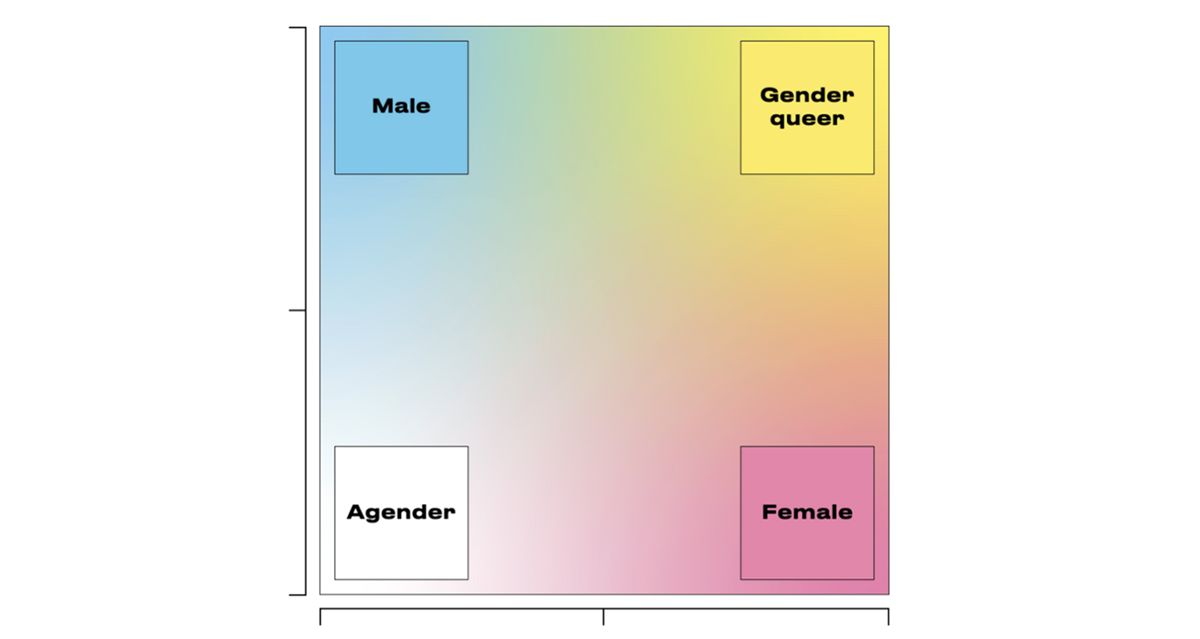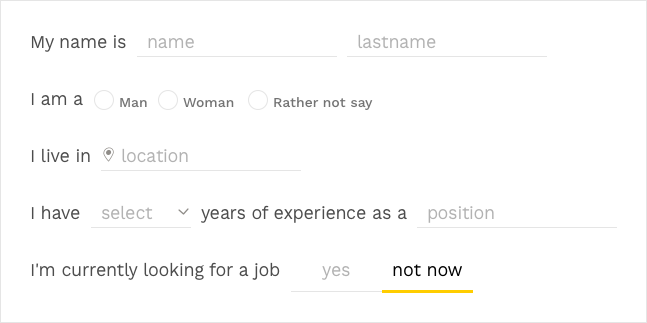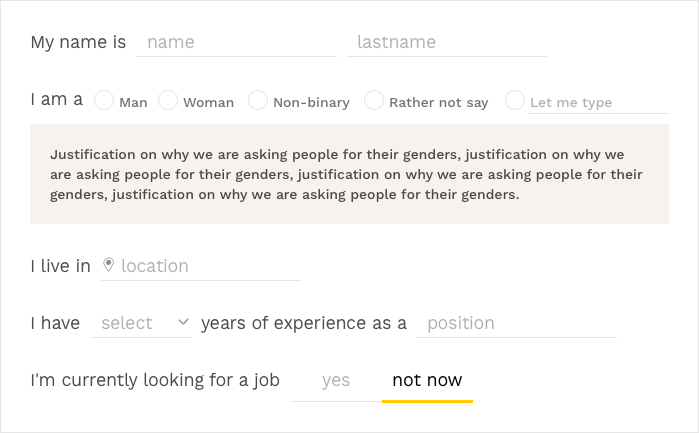How to design gender inclusive forms
— Erica Scolaro, Product Designer @ Welcome to the Jungle
When creating a product for a wide range of users it is very important to be aware of the many differences between them. Especially in an account-based product, we need to ask people their gender in a thoughtful and respectful way.
Advocating gender diversity inclusion is worth pursuing as gender fluidity is becoming increasingly accepted in our society, making this community a growing part of our users. Small changes can be made in our products to show acceptance and recognition.
As the majority of products remain stuck in a binary gender identification, the experiences of Gender Non Conforming (GNC) people have not been prioritized. And it’s our role as designers to consider the experience of all our users, not just the majority.

The first question is, why are we asking?
It is important for product teams to be conscious and intentional with how they use the data they ask for. With the General Data Protection Regulation (GDPR) already in effect in the EU, and many states enacting their own data privacy legislation, it can cause some friction.
If you need gender information for marketing segmentation, consider whether your audience’s attitude is really different based on gender. One’s gender expression, gender identity, and gender assigned at birth may not be the same. Rather, people may have an infinite variety of gendered experiences in the world.
Sex or gender?
Although the human experience is not divided into separate biological and socially constructed parts, gender and sex are different things. Broadly speaking, the term "sex" refers to the biological differences between male, female, and intersex people and is generally assigned at birth. "Gender" refers to something more complex, personal and individual (way outside of the "man or woman" binary) and the way we express our gender can be another layer of personality.
In our case study, a form input for an account, the data we need has nothing to do with the sex assigned at birth, we therefore need to ask for gender.

The UX approach
As designers, we need to remember that it is part of our job to improve the inclusiveness of user experiences. This also applies when someone else before us has not taken this into consideration when designing the first draft of a product. Keep in mind that design is an infinite process and improving our product is as big of a job as creating it from scratch.
— Ruined by Design, Mike Monteiro
Case study

The animal kingdom
👎 The options listed are semantically disconnected from the label for the field. Male/female refers more accurately to sex than to gender. Plus, intersex people are very frequently overlooked in these situations.

The binary system
👎 This form is a good example of a common mistake. Gender is a non-binary social construct, meaning it's missing many more options. Plus there is no explanation of why this private, sensitive information is required. Whether we need to know gender or sex, the options given are not inclusive.

The "third option"
👎 Even though this option seems better because it gives the user the option not to disclose their gender, it is not inclusive either.

Getting somewhere…
☝️Some other genders are non-binary, intersex, transgender, agender, Two-Spirit, genderqueer or gender non-conforming (GNC). But it’s impossible to list every gender, and if we tried, it'd be really confusing. It is usually best to do your research into the gender identities which are most common in your area/field (for example, Two-Spirit is a Native American non-binary gender identity), and be vigilant in including an option for users to type their own answer.

Custom option
☝️It’s crucial that we include the option for people to type their own answers. Avoid using the word “Other” as the typing option – firstly, it’s not obvious it'll lead to the chance to type, but it’s also not nice to feel as though you are an afterthought.

Transparency
☝️As mentioned before, as a company we need to be transparent with people on how and why we are asking for such personal, sensitive information. This seems like the best option if this field is mandatory.
This is a "good enough" solution. Or to say it differently, it's a solution to the technical problem. Let's try to find a solution to the ethical problem.
Disclaimer: asking for pronouns can be a good alternative in some cases. But keep in mind that besides the she/he/they there are many neo-pronouns so a "Let me type" option would be necessary. In our case study, the users don't interact with one another so the 3rd person speech is never used, therefore pronouns were not necessary.
If we circle back now…
…to the first question, why are we asking for one's gender?
At Welcome to the Jungle we define ourselves as a multichannel media company that aims to inspire every individual to thrive in their professional lives. Since our goal is to inspire every individual, why would we separate gender? We don't target different audiences depending on their gender. Especially since our brand is about work-life and the relationship we have with our job, it has nothing to do with your gender.
Over the 3 196 companies online right now on our website, 1 217 decided not to display the male-female parity data on their profile. Whether it was because they didn't think this ratio was relevant or they didn't want to exclude the non-binary identifying people, 38% believed this data wasn't a good representation of how gender equality in a company should be handled.
Why is gender important when you are recruiting someone? Why do we even need this stat? Changing your speech to have 50% male/50% female (on the binary system sadly used too much) is discriminatory already. That's not gender equality, that's data equality.
45% of our users are between 18 and 26 years old (Generation Z), this demographic is the most sensitive about gender issues. They are also the primary population using non-binary pronouns or defining themselves as non-binary.
Gender discrimination is very common at work and the only way to overcome it, is to hide the gender you identify with when filling a job application form. This way we wouldn't even give the opportunity to discriminate.
Another delicate subject is the question of transgender people. Transitioning is more of a process than a state of gender, should we ask someone undergoing a transition what they identify as? Is this going to have an impact on the way we treat them as a new employee? It shouldn't. Is this going to change the male-female parity data?
If you followed this entire article you understand now why this binary system of classifying people is flawed and outdated. If one employee transitions in a company, the ratio changes, but does the quality of the company's work change? Does productivity change? No it doesn't. Then, why would information as personal as gender identification have any impact on a company?
Conclusion
Gender is a social construct and it is challenged everyday by the queer community, who are often discriminated against or forgotten. As designers, it is our duty to include every part of the gender spectrum and make people comfortable when designing a product that is advertised "for everyone".
We need to start by asking ourselves "is this really necessary?", "Is our user’s gender going to affect their experience within our product?". If any of these answers are different than an absolute yes, you might need to consider not asking for a gender.
In the case where it is necessary, keep in mind that not everyone is comfortable giving away this information. So you should disclose the reason why and how it will affect their experience.
Lastly, if gender equality is your goal, you shouldn't focus on data recovered from inputs on a form. Adapting the company's behavior one way or another to balance the gender ratio, is gender discrimination. Gender blindness is real gender equality.
— Erica Scolaro, Product Designer @ Welcome to the Jungle
Sources:
